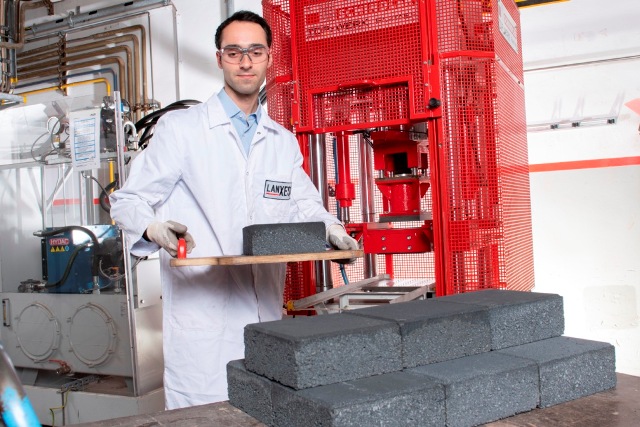LANXESS: Strong partner for concrete coloring
Modern concrete formulations are based on the use of highly specialized additives. As a result, they exhibit considerably improved properties with regard to load-bearing capacity, workability, durability and design scope. The individual constituents in these ever more complex recipes must be highly compatible in order to meet the target performance requirements. These target requirements must also be kept in mind when selecting iron oxide pigments, whose properties make them the material of choice for coloring concrete materials. Sound advice and application-specific support from an expert on pigments can be of great value here. Specialty chemicals company LANXESS is known worldwide for its expertise in the field of concrete coloring. The company recently invested around EUR 1 million in the further modernization of its application technology laboratory for construction materials.
With a production volume of approximately 375,000 metric tons per year and production facilities on five continents, LANXESS is a leading provider of synthetic iron oxide color pigments. The company, which offers comprehensive technical service along the entire process chain, has made targeted investments to significantly expand its global application technology offering.
Be it for conventional concrete products such as paving stones or concrete roofing tiles or for in-situ construction applications, manufacturers are increasingly relying on innovative concrete materials whose formulations have often undergone additional modifications. For example, self-compacting concrete (SCC) can be used to create surfaces with a variety of structures and an outstanding look and feel.
Whether colored concrete surfaces meet the desired target color is not determined by the pigment selection alone. There are a variety of possible influencing factors related to the selection of raw materials and additives used. Unwanted effects that can appear in the form of signs of material segregation or poor workability of the concrete can generally be avoided by obtaining professional advice at the outset.
The whole spectrum of pigment expertise
LANXESS has extensive expertise in the production and handling of pigments and their optimal use in concrete applications. In order to continue to provide competent support for the future technological developments of its customers, the company has expanded its application technology laboratory for construction materials and the technical center for pigment applications at its production site in Krefeld-Uerdingen, Germany. With an area of roughly 1,000 square meters, the facility is equipped with state-of-the-art technology. This center of excellence offers extensive testing and analysis of the physical properties of the pigments as well as their effects in concrete.
Colorimetric problems in customer-specific applications can be analyzed reliably under the electronic microscope. The cause of the problem is often determined by analyzing the shape of the primary pigment particles and their distribution in the hardened concrete or mortar structure.
Color matching to meet customer specifications can be made in existing and new concrete formulations by using modern color measuring technology. Accurate measurement of the precise color coordinates are determined on the basis of the CIELab color system for all cement based applications.
Transportation stability, dispersibility, and adjustment of color shade are important interdependent properties when it comes to selecting pigments for fresh concrete mixtures. LANXESS creates realistic simulations of the production conditions at the customer’s site to determine the most suitable pigment selection. To this end, the necessary degree of hardness is determined, for example by using a ring shear cell or by conducting conveying tests on the in-house batching system. Pigment behavior in the actual application is then simulated, taking into account the installation-specific mixing time and associated energy input. In this way, the desired color shade can be reliably achieved.
Concrete strength must also meet specified criteria when color pigments are added. LANXESS is able to test key material properties such as the modulus of elasticity and compressive strength by conducting non-destructive and destructive standard tests on customer samples. The company also offers more specific tests of individual concrete components at the customer’s request. For example, carbonation resistance testing or fineness testing using the Blaine method.
Consistency checks in the usage of iron oxide ensure trouble-free processing of the concrete at the customer as well as reproducible coloring. LANXESS prepares recommended recipes for its customers which take into account the raw materials used and process equipment available. Slump testing to recognized standards is used to check the consistency of concrete samples. Additional rheological tests can also be used to optimize flowability and viscosity. The use of modern mixer technologies within the Technical Center also helps to accurately simulate production conditions at the customer.
Application testing on an industrial scale for block paving, concrete roof tiles, and in-situ or precast concrete enable the LANXESS experts to simulate customer problems under realistic conditions. The test equipment can also be used to verify the effectiveness of suggested solutions. The company provides customers with samples upon request.
As part of its extended technical service offering, LANXESS conducts extensive tests of the physical and material-specific pigment characteristics and provides well-founded recommendations for the modification of customer formulations. To this end, the company works together closely with raw material producers, plant manufacturers, architects, and universities.
Practical challenges in concrete
How important it is for companies that process concrete to seek the advice of a pigment expert can be seen in the context of concrete applications in practice. In the case of ultra-high-strength concrete, for example, structural evidence must be provided that the addition of pigments does not impair the compressive strength of the concrete. LANXESS can perform such compressive strength tests at its laboratories. In addition, Bayferrox iron oxide pigments have been certified to DIN EN 12390-3 by an independent external institute.
The production and processing of colored black self-compacting concrete (SCC), for example, requires a deep understanding of the potential interactions between the pigments and the plasticizing additives. Tests performed by LANXESS have shown that the make-up of the concrete formulation can have negative effects on the pigment distribution in the concrete substrate. Our pigment specialists have prepared tailored solutions for customers on the basis of laboratory tests.
Practical training for optimal coloring of construction materials
In addition to technical advice, LANXESS offers its customers an intensive laboratory training program that teaches the participants how to handle iron oxide pigments and provides numerous tips on how to process them. The aim of the “Bayferrox Color Workshop” is to make the production of colored concrete products more sustainable and more efficient. The participants receive both theoretical and practical training from pigment experts. The agenda includes topics such as color theory and color matching, production methods, formulation, and quality control. In the practical part, the participants can learn about techniques for adjusting existing color shades and find out which factors can affect the final color of a concrete product. The “Bayferrox Color Workshop” takes place regularly in different regions and attracts participants from all over the world.
@EPC World Media
















